How oat milk stacks up to cow’s milk
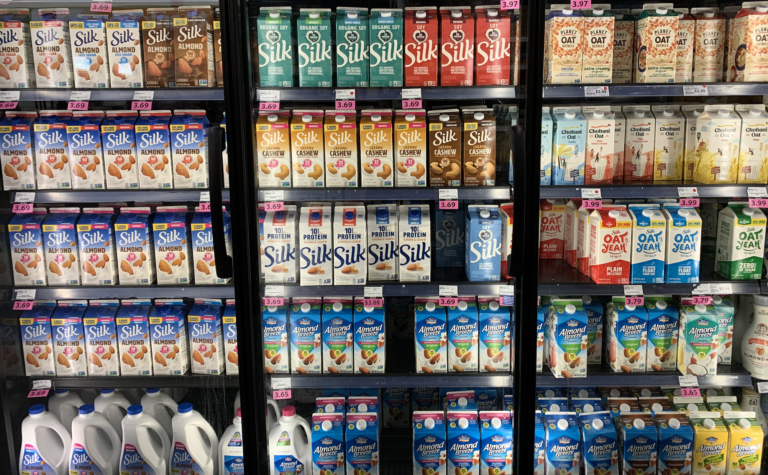

If you watched the Super Bowl, I doubt you’ve been able to forget the Oatly commercial.
In case you missed it, the Oatly CEO is sitting at a piano and belting out “oat milk, it’s like milk but made for humans” for about 30 seconds straight. It was uhh… unique to say the least.
To be honest, I’m not sure what the CEO really meant by “it’s like milk but made of humans,” but it did get me thinking about oat milk and how it would compare to cow’s milk. Was it healthier? Worse?
You better believe I ventured off to the grocery store to buy oat milk for the very first time. So, here comes the nutritional breakdown for cow’s milk versus oat milk.
The competition
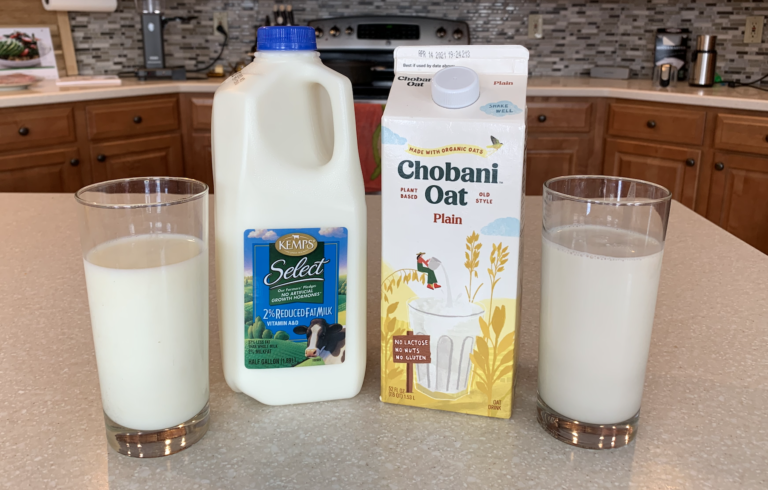

I was looking for Oatly branded oat milk but couldn’t find it in any store near me. Instead, I had to settle for Chobani Plain Oat and Kemp’s cow’s milk.
Both are standardized to 2% fat meaning the overall fat content is the same. I did this on purpose because there are many other nutritional differences to point out. Fat content won’t be discussed in detail here.
Now before we get into the nutritional differences between the two milks, let’s quickly compare how they are manufactured.
Production: How do oats make milk?
Okay, I’m assuming we all know where cow’s milk comes from, but oat milk is a bit more mysterious.
So, how does a hard, dry grain get transformed into a milky liquid?
Oat milk begins as a mixture of rolled oats and water that gets blended, ground, or otherwise pulverized into a fine slurry.
The oat slurry is then filtered to remove any large particles and what remains is an oat flavored beverage.
The water is used to extract — or draw out — certain compounds from the oats. This process is similar to making tea from leaves or coffee from beans.
Next, the canola oil (also called rapeseed oil) is stirred into the beverage as tiny droplets. It’s these oil droplets that give the beverage its opaque, milky color.
You might also notice that a thickener, gellan gum, is added to the milk to increase the viscosity and lend a thicker mouthfeel.
It’s these extra ingredients that allow oat milk to appear and taste similar to cow’s milk. There’s no reason that an oat beverage would have to resemble milk, but it’s been formulated to specifically mimic cow’s milk because that’s what most people are familiar with.
Protein power
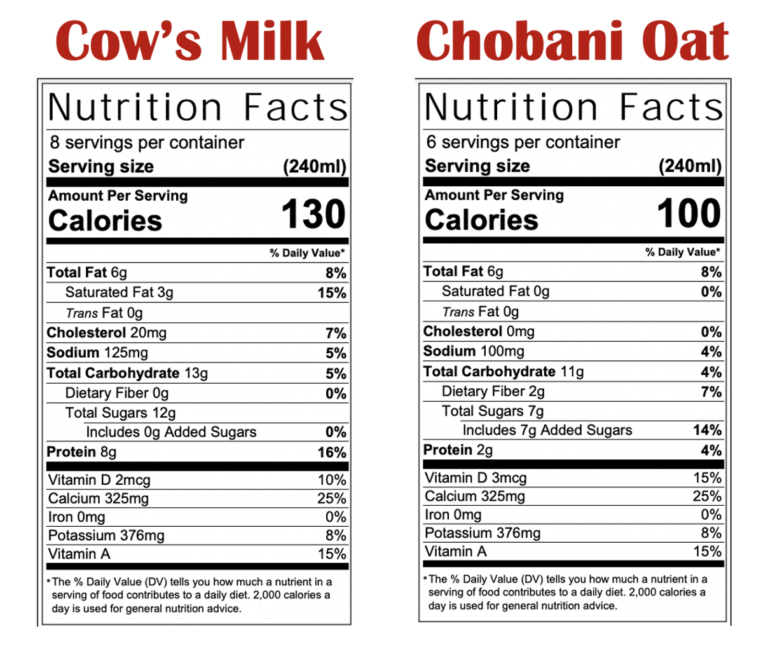

When it comes to protein, cow’s milk is going for gold.
One glass of cow’s milk contains 8 grams of protein compared to just 2 grams in Chobani Oat.
I glanced at some other brands of oat milks while still at the store and many had 1 gram or less of protein. So be careful and always double check the protein content before buying oat milk and other plant-based milks.
Another benefit of the protein in cow’s milk is that it’s considered a completeprotein. This means it provides all the amino acids the human body can’t make so we must consume them.
Few plant proteins have the right amino acid profile to receive this name, so this is definitely a plus for cow’s milk.
Total sugar and added sugar
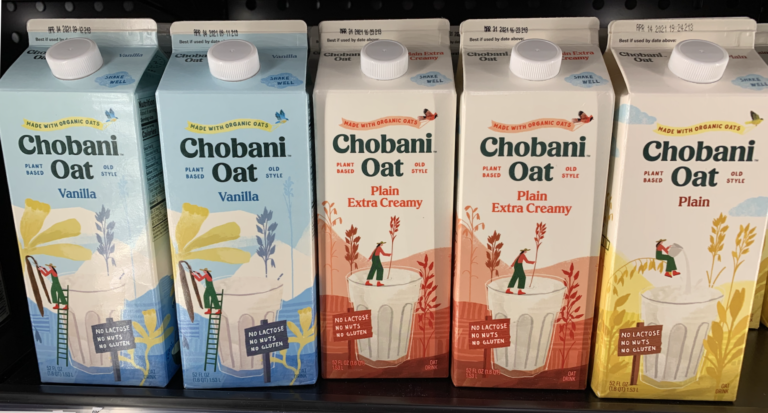

When it comes to sugar there are two numbers I want to talk about — total sugar and added sugar.
Now this might come as a surprise but cow’s milk has more total sugar with 12 grams per serving compared to Chobani Oat with only 7 grams.
Where the difference between the two comes in is with the amount of added sugar.
You’ll notice cow’s milk has no added sugar, meaning it only includes the sugar that is naturally occurring in the milk. Most plant-based milks are adding sugar into the beverage to make the drink more palatable and sometimes it’s A LOT of sugar.
The plain version of Chobani Oat isn’t bad, like I said only 7 grams of added sugar per serving, but be particularly careful if you’re buying flavored plant milks like chocolate or vanilla. You’ll see that these can contain much larger amounts of added sugar than their unflavored versions like Plain Chobani Oat here.
Need more fiber?
One perk of oat milk is that it contains 2 grams of fiber per serving whereas cow’s milk doesn’t contain any.
The fiber in oats is a special type called beta-glucan, which has been linked to a plethora of good health outcomes like greater GI health, lower blood glucose levels, and lowering cholesterol levels.
Now, if you eat a lot of fresh fruits and veggies you probably don’t need a milk with fiber, but if your fiber intake is something you worry about, maybe it’s time to try oat milk.
Look for “fortified” oat milk
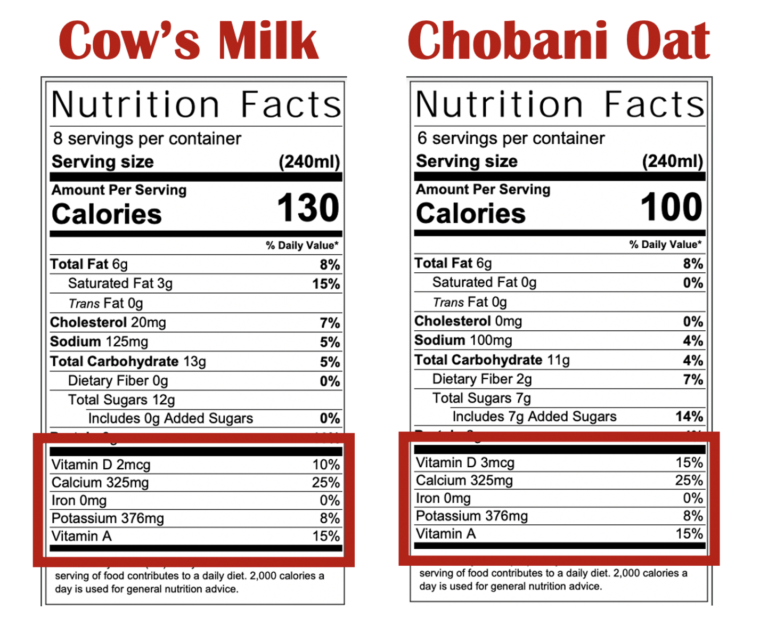

If you are thinking of switching from cow’s milk to oat milk be sure to find an option that’s fortified. This means specific vitamins and minerals are added to the beverage and match the vitamins and minerals in cow’s milk.
Looking at the nutrition label, you can see Chobani Oat is fortified to contain nearly identical amounts of vitamin A, vitamin D, calcium, and potassium as cow’s milk. Any oat milks that aren’t fortified wouldn’t include these micronutrients and may lead to a deficiency in your diet.
Price point
A switch from cow’s milk to a plant-based milk will come at a cost literally.
The half gallon of cow’s milk that I picked up was about two bucks while the Chobani Oat was on sale for $3.99. And it doesn’t seem like it’s just oat milk, but most plant milks will require a higher budget.
Get ready to double the amount of money you spend on milk if you’re going to opt for plant-based beverages.
Got allergies?
Another benefit of oat milk is that it’s a hypoallergenic option, although check the product label to make sure it’s not processed in a facility with other allergens like wheat, peanuts, or soybeans.
Also, if you’re lactose intolerant, oat milk might be a good option for you. Only cow’s milk contains the lactose so any plant-based milk should be easier on your body.
When it comes to cow’s milk and oat milk there isn’t a clear winner. It depends what’s most important to you.
If you use milk as a good source of protein, cow’s milk is the way to go. However, if you’re looking to add fiber to your diet or cut out some sugar, Plain Chobani Oat is a better option.
And one last point, just because a drink is plant-based doesn’t automatically make it healthier, so always be sure to check the nutrition label.
If you’re interested in other plant-based milks, check out my brief guide already published on Medium.

